Disclosure: Meeple Mountain received a free copy of this product in exchange for an honest, unbiased review. This review is not intended to be an endorsement.
As I was sitting in my first meeting with Ion Game Design at this year’s SPIEL event, I had a moment where my proverbial jaw hit the floor.
Thanks to the work of Content Marketing Manager (and “Overall Genius”, per her signature) Hanna Oinonen, I was sitting across from Ion’s Lead Game Designer & Creative Director, Jon Manker. In my circles, Ion is known for many things, most notably the release of High Frontier 4 All, which depending on your search parameters is the single-most complex game listed on BoardGameGeek. High Frontier 4 All is so complex that each time I’ve had the chance to sit through the two-hour teach videos I’ve found (or the 6-7 hour playthroughs online), I have wilted in fear…does any game need to be that complex?
(The answer, per my heavy strategy gaming friends, is a resounding “yes.”)
I’ve always been impressed with Ion from afar, so I pushed to get a meeting with this team to learn more about the rest of the catalog. That’s when Jon dropped it on me—there, off to my right and his left, was a game called StegegetS Moomin, a new family game that is based on the Moomin universe of characters created by Tove Jansson. (Moomin is new to me, but it reminded me and my family of the Richard Scarry world of characters found in the “Busytown” book series.)
Jon and I talked about a lot of different Ion products that have been released in the last couple years, as well as what’s coming up for Ion. I asked if we could cover StegegetS Moomin and Jon was gracious enough to offer a review copy of the game.
As it turned out, StegegetS Moomin was one of the first games I got to the table after getting back from Germany. I guessed that my kids—particularly my nine-year-old daughter, a future creative design superstar from the looks of her early work creating graphic novels and original stories for our family—would quickly take to the look and theme of the game.
I was right. And then some.
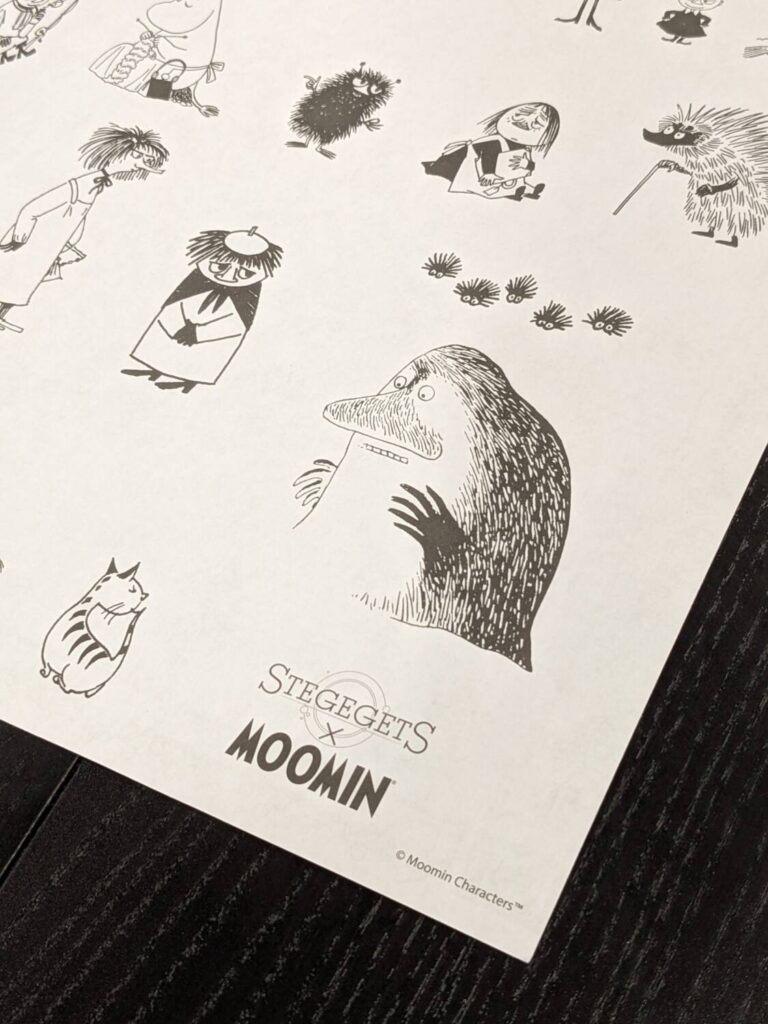
Roll, Write, Color
StegegetS Moomin is a 2-6 player roll-and-write game that takes place on a board that is actually a large poster-size sheet of paper.
Let’s start there. When I opened the box, I was greeted with a pleasant surprise. There’s no insert. You get six colored pencils in six different shades, a bunch of dice in both red (strawberry, technically) and purple, a rulesheet, and a massive pad of paper folded in half. Unfolded, you get the game’s main board on each sheet—the board displays Moomin Valley plus all of the characters in the game and a scoring area for each player along the border of the sheet.
Gosh, this is a great presentation. Then, it gets better—you peel off a sheet that sits in the middle of your table with the entire board, and if you flip the sheet over, you’ve got different pictures of characters from the Moomin world in varying backgrounds…all meant to be drawn on and colored by the group before or after the game is over. You could argue that StegegetS Moomin is a game, or that it is an oversized coloring book, and you’ll find supporters on either side of the argument.
So for a family game, StegegetS Moomin is already a bit different from a lot of the family games I get to try. Then, there’s a game attached, one that ends up being quite delightful, particularly if you love games like Yahtzee, Tenzi, or anything that includes a reroll function.
In the base game of StegegetS Moomin, everyone picks a character and colors the border surrounding that character on the map. There are maybe 30 characters scattered around the board, and starting with the youngest player, each person selects a character that really doesn’t have an active part during gameplay. It’s just an excuse to say that you are Misabel, Moominmamma, Snorkmaiden, or someone else with a funny name.
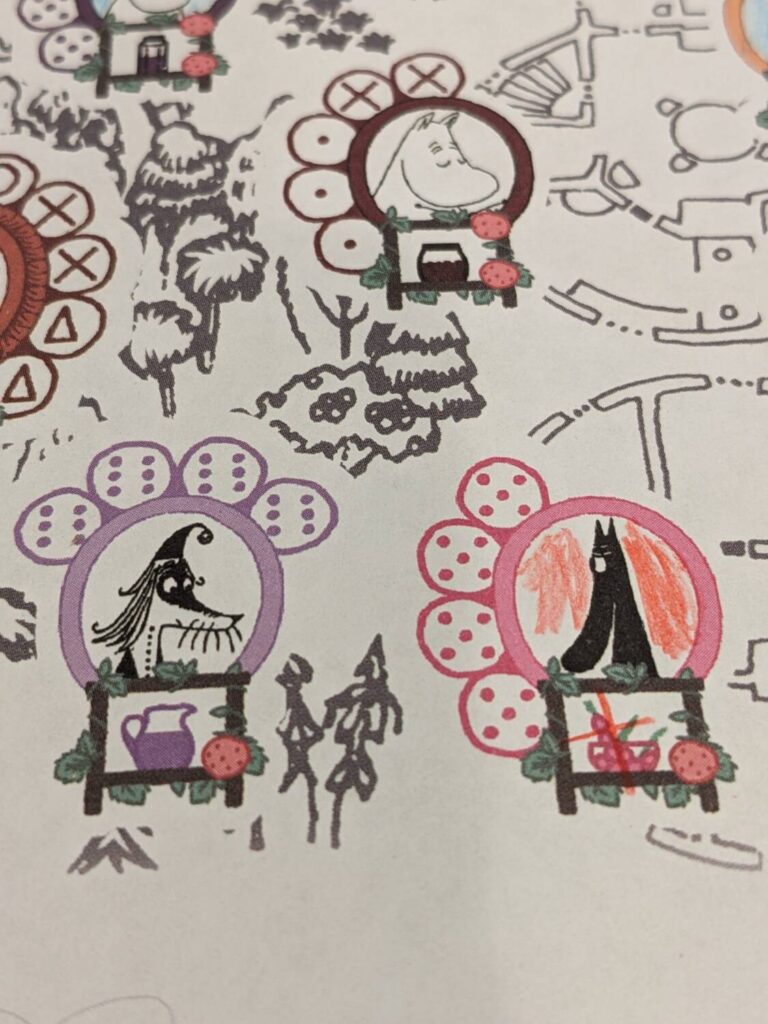
Then the active player takes all of the strawberry dice and rolls them. The dice are standard six-sided dice with pips running from 1-6. Then that player (or, in my experience, all players, because even though the game is competitive, a portion of each player’s turn becomes cooperative) looks around the map of Moomin Valley. All of the characters’ spaces in the Valley are drawn with a little portrait around their headshot, with a variety of symbols meant to indicate how players can find each character.
From then on the game becomes a bit of Yahtzee-style matchmaking; games like King of the Dice feature similar mechanics. Rolled dice can be used to access the characters. Maybe you rolled four 4s; one of the characters is activated by ending a turn with that specific die total. Other characters have symbols—two Xs, two Os, two triangles. That means a player that rolled two 2s, two 3s, and two 6s could use their roll to visit this character.
Don’t like your roll? Players start the game with two strawberries filled in below their personal scoring area; a player can cross out a strawberry to reroll any number of dice, which helps when you come up empty on a turn. More strawberries are earned during play, so there are usually ways to mitigate a bad roll with a timely reroll.
When you submit a final die result, the active player colors in the character portrait if it is colorless. Then they earn strawberries and a gift or two from that character; those gifts are what drive scoring in StegegetS Moomin, and some gifts are more valuable than others. If a player visits a character that has already been visited and colored in during a previous turn, that player still earns a few strawberries for their efforts, but no gifts. Instead, they are given a bonus purple die that can be used on their next turn, to increase the chances that they will receive a gift from a different character.
And that’s it. After six rounds, the game ends with a winner determined by whoever has the most total gifts. Ties are broken by whoever has more of the most valuable gifts in rank order.

Art is Life
What we enjoyed most about StegegetS Moomin was how it elevated something we know well into something that looks gorgeous on the table.
I mentioned King of the Dice earlier. It’s a fine game, but a game that my kids didn’t ask to play over and over again. The production was OK, with dice that might have been the exact same production dice used in StegegetS Moomin, which is to say that the dice are also just fine. King of the Dice ran a bit too long for my kids, which ultimately pushed that game out of my collection.
What StegegetS Moomin does exceptionally well is provide flexibility in a much more accessible package. The final product also changes so much that by the end of play, we go from a good-looking sheet of black-and-white paper to a better-looking, colorful tableau that has real personality.
And there’s depth available here if players want it. Additional variants include character powers, the ability to manipulate die rolls, or get bonus gifts, or other fun extras that are easy for my kids to lean into when they want to spice things up.
One extra I would not include: varying the number of rounds by player count. The manual lists an option that features 12 rounds for two players, 11 rounds for three players, etc. My advice: play six rounds no matter how many people are at the table. That will usually keep this under 30 minutes with four players (I only tried the game with my family of four), and that’s just right given the weight of the experience.
StegegetS Moomin was a big surprise for me. For those seeking a unique experience (both as a gift, or for your own family), this one fits the bill!



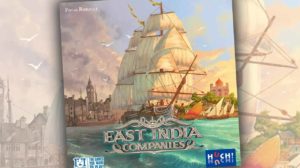

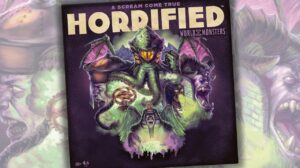
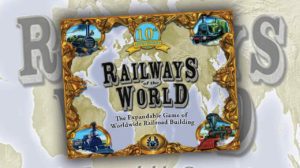




Add Comment